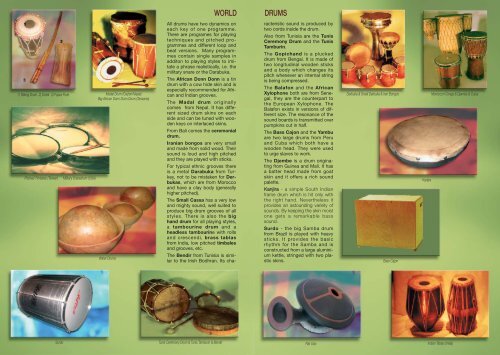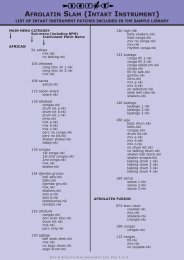EthnoWorld 3
EthnoWorld 3
EthnoWorld 3
Create successful ePaper yourself
Turn your PDF publications into a flip-book with our unique Google optimized e-Paper software.
WORLD<br />
DRUMS<br />
1) Talking Drum. 2) Dolek 3) Fujara Flute<br />
Pitched Timbales (Taiwan)<br />
Military Snaredrum (USA)<br />
Madal Drum (Ceylon/Nepal)<br />
Big African Donn Donn Drum (Tansania)<br />
Water Drums<br />
All drums have two dynamics on<br />
each key of one programme.<br />
There are programes for playing<br />
techniques and pitched programmes<br />
and different loop and<br />
beat versions. Many programmes<br />
contain single samples in<br />
additon to playing styles to imitate<br />
a phrase realistically, i.e. the<br />
military snare or the Darabuka.<br />
The African Donn Donn is a tin<br />
drum with a cow hide skin and is<br />
especially recommended for African<br />
and Indian grooves.<br />
The Madal drum originally<br />
comes from Nepal. It has different<br />
sized drum skins on each<br />
side and can be tuned with wooden<br />
keys on interlaced skins.<br />
From Bali comes the ceremonial<br />
drum.<br />
Iranian bongos are very small<br />
and made from solid wood. Their<br />
sound is loud and high pitched<br />
and they are played with sticks.<br />
For typical ethnic grooves there<br />
is a metal Darabuka from Turkey,<br />
not to be mistaken for Derbukas,<br />
which are from Morocco<br />
and have a clay body (generally<br />
higher pitched).<br />
The Small Cassa has a very low<br />
and mighty sound, well suited to<br />
produce big drum grooves of all<br />
styles. There is also the big<br />
hand drum for all playing styles,<br />
a tambourine drum and a<br />
headless tambourine with rolls<br />
and crescendi, brass tablas<br />
from India, low pitched timbales<br />
and grooves, etc.<br />
The Bendir from Tunisia is similar<br />
to the Irish Bodhran. Its characteristic<br />
sound is produced by<br />
two cords inside the drum.<br />
Also from Tunisia are the Tunis<br />
Ceremony Drum and the Tunis<br />
Tamburin.<br />
The Gopichand is a plucked<br />
drum from Bengal. It is made of<br />
two longitudinal wooden sticks<br />
and a body which changes its<br />
pitch whenever an internal string<br />
is being compressed.<br />
The Balafon and the African<br />
Xylophone both are from Senegal,<br />
they are the counterpart to<br />
the European Xylophone. The<br />
Balafon exists in versions of different<br />
size. The resonance of the<br />
sound boards is transmitted over<br />
pumpkins cut in half.<br />
The Bass Cajon and the Yambu<br />
are two large drums from Peru<br />
and Cuba which both have a<br />
wooden head. They were used<br />
to urge slaves to work.<br />
The Djembe is a drum originating<br />
from Guinea and Mali. It has<br />
a batter head made from goat<br />
skin and it offers a rich sound<br />
palette.<br />
Kanjira - a simple South Indian<br />
frame drum which is hit only with<br />
the right hand. Nevertheless it<br />
provides an astounding variety of<br />
sounds. By keeping the skin moist<br />
one gets a remarkable bass<br />
sound.<br />
Surdo - the big Samba drum<br />
from Brazil is played with heavy<br />
sticks. It provides the basic<br />
rhythm for the Samba and is<br />
constructed from a large aluminium<br />
kettle, stringed with two plastic<br />
skins.<br />
Derbuka & Small Derbuka & Iran Bongos<br />
Bass Cajon<br />
Kanjira<br />
Moroccon Conga & Djembe & Cuica<br />
Surdo<br />
Tunis Ceremony Drum & Tunis Tamburin & Bendir<br />
Flat Udo<br />
Indian Tablas (India)






